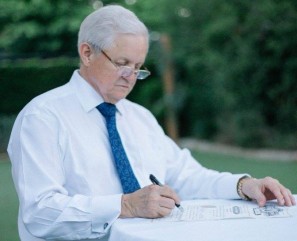THIS OLD HOUSE TEACHES A LESSON
By DANNY MINTON
Growing up, my hometown of Plano was just a small rural community out in the middle of cotton farms and cattle where you could see for miles across freshly plowed fields and grazing pasture. It was 5 to 10 miles to the nearest town in any direction from downtown. The population in 1950 was 2,126. When I moved there in 1954, it had probably grown by only a couple of hundred. It was a peaceful little town with little controversy and where everyone knew pretty much everyone else in town.

Danny Minton
Today, with a population approaching 300,000, Plano is far from the town in which I grew up. The old downtown has become more of a young professional setting with apartments, coffee shops, and galleries. The stores and buildings I remember are either gone or converted. Now you travel 10 to 12 miles in any direction, and you are still in some city or another. Cotton fields and grazing pastures are now houses and businesses.
One exception is the Collinwood house, the oldest house in Plano, and that one exception was the middle of a big controversy between old and new. The city owned the land and voted to tear down the 1861 structure to make way for a new park. The city council, none of whom were a part of the early town, see it as progress and have no ties to the home or city of 60 years ago. On the other hand, there is a historical group that raised money to fix up the house and keep it. After all, it has meaning to the city as part of its culture and history. So the city stood at a standstill until a decision emerged, old vs. new, progress vs. culture and young vs. old.
I see this in churches as they grow and deal with many different issues. An older member told me that some of the older members don’t think the elders care for them as much since they always tend to be talking about the younger families and all their needs. They don’t come to their classes, and few show up at events, so they feel that they neglected. More weight placed on the opinions of the younger generation feelings and desires than the older.
On the other hand, I heard that some younger folks thought that the church catered too much to what the older folks wanted, impeding progress because we didn’t want to hurt their feelings. More weight placed on the opinions of the older generation and their feelings than what the younger generation wanted to see done.
Therein lies the challenge. Plano exploded from a community of 2,000 people with the same thinking and background to a 300,000 diverse, multigenerational city. On the way, as the town grew into a city, it lost the closeness that many held dear. At the same time, great strides resulted in developing a modern highly ranked city.
Churches that grow become like cities. You have those that have been there from the beginning, seeing it when it was small and watching it grow and serve the Lord. Then somewhere along the line, those become fewer, and a new generation begins to be more involved and active. The older generation doesn’t always understand the younger group and why they want to change everything and the younger group on the other side has no connection with the past that many hold so dear.
To meet the challenge, the leadership has to make a decision to lead and not take sides with one group or another. Their goal as leaders is to help people understand each other, teaching those that follow to work together in unity. Allowing one group to drag behind pulling down those trying to move forward will only hinder the Lord’s work. On the other hand, allowing another group to push forward, leaving bodies that can’t keep up to fend for themselves tenders the same result.
Each leader has a certain group they are closer to, so it is up to them to help that group see things, not only the way they view them but to try and see things through the eyes of others. Most of all we need to be teaching each other to see things through the eyes of Jesus and what God wants, avoiding the pitfall of convincing ourselves that what “I” want is God’s will.
They must teach those who are older to grab hold of the enthusiasm and excitement of those who are younger and work with them in moving forward. In contrast, leaders must teach the younger generations not to forget that there is wisdom in those who have traveled roads before and take hold of what those who are older can offer to help bring a congregation together as it moves into tomorrow.
Back to the Collinwood house. The answer is simple if the two sides worked together, incorporate the old with the new, somehow keep the park holding on to the history of the house. It doesn’t have to be old vs. new, but old and new working together, moving forward, but remembering the good from the past. And working together, that’s what happened. Instead of tearing the house down, it was moved to another location, making way for a park and keeping the history intact for generations to come.
________________________
The LORD makes firm the steps of the one who delights in him;
though he may stumble, he will not fall, for the LORD upholds him with his hand.
I was young, and now I am old, yet I have never seen the righteous forsaken or their children begging bread.
They are always generous and lend freely; their children will be a blessing. Psalm 37:23-26
Danny Minton is Pastoral Minister and Elder at Southern Hills Church of Christ
